Ed. note: This piece is part 2 of the Eating Ethically and Affordably in Vancouver series originally from the Tyee, and is reposted here with permission. Part 1 of this series can be found on Resilience.org here.
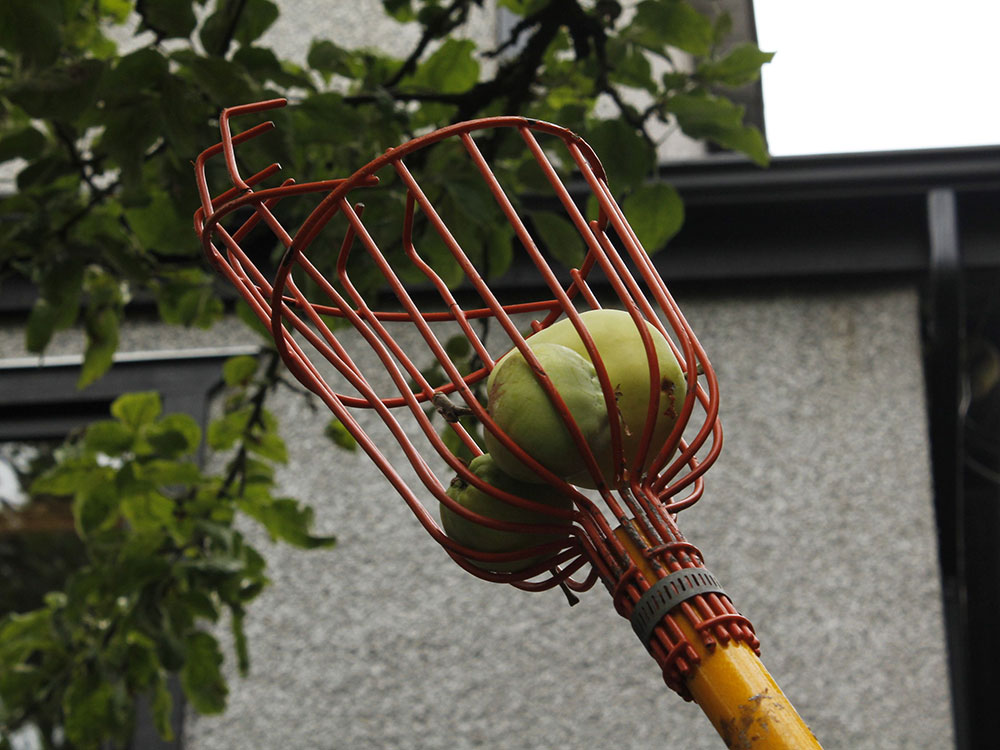
Go, go extendo arms! To reach delicate fruit hanging from a tree’s upper branches fruit tree pickers will use these baskets, attached to extendable poles. The idea is to cup the fruit and gently push upwards against its stem which makes the fruit pop off the tree and into the basket. Photo by Michelle Gamage.
The steep hills of ritzy West Point Grey are not what I had in mind when I set out to find a new fresh and affordable food resource in Vancouver.
But here I am, wheezing as I pedal up the quiet road at 7:30 a.m. on an overcast day in July.
My destination was emailed to me the night before. When I arrive, I walk my bike around the side of the stranger’s house and am greeted cheerfully by someone whose body is obscured by the leafy branches of an apple tree.
I’m here to volunteer with Vancouver Fruit Tree Project, an organization that brings volunteers in to pick unwanted fruit off trees on private property and then donates the food to community partners, like Carnegie Community Centre, the Downtown Eastside Women’s Centre and Vancouver Native Housing Society.
But, as my volunteer co-ordinator carefully explains, there’s limits on what kind of food can be donated. For example if fruit is too bruised, worm-bitten or touches the ground, even for a second, it goes in a separate pile.
That’s the pile I’m here for. Volunteers are encouraged to bring their own bag to take this fruit home.
Maybe my solution to finding fresh, affordable food in the city is to pick it myself.
In part one of this series, published last week, I explored urban farms, community gardens and new and innovative ways to connect with small-scale farmers in the Lower Mainland.
This week I’m focusing on fruit trees and berry bushes growing around Vancouver. They produce incredible amounts of food in Vancouver’s temperate climate.
I’ve harvested wild berries my whole life and landmark time based on the colours my fingers are stained in pictures, or the scratches that run criss-cross over my knees and arms where the bushes fought back.
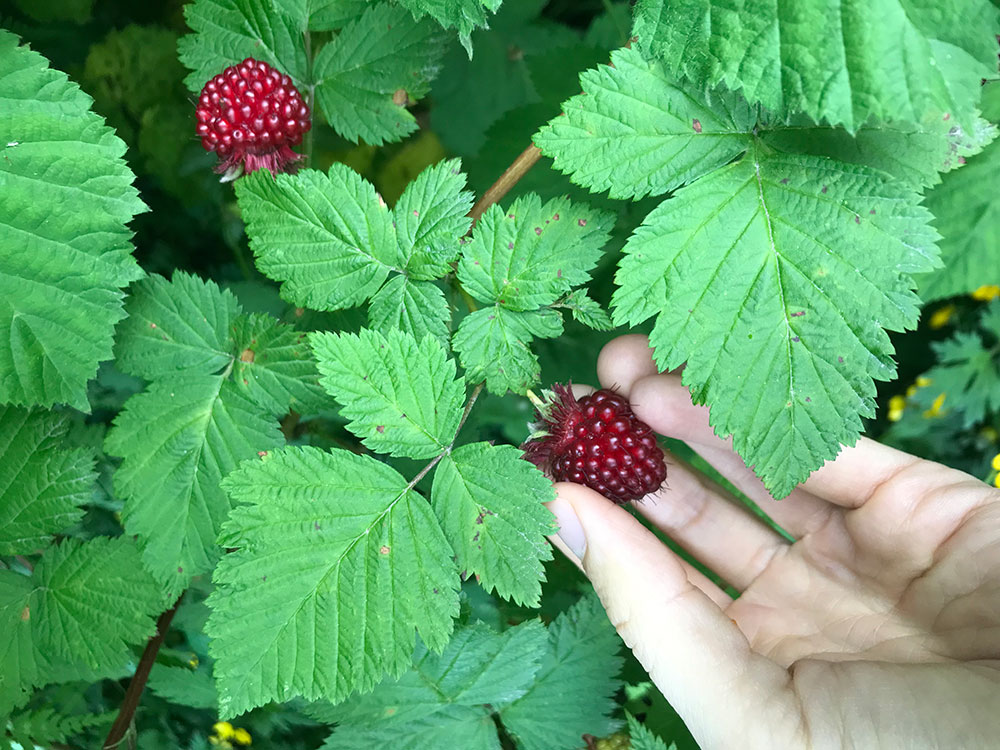
Salmon berries harvested from the edges of Northwest Marine Drive near Spanish Banks. Depending on the bush, these raspberry-like berries will blush a golden yellow or rich wine-red when they’re ripe. Photo by Michelle Gamage.
Salmon berries are the first to appear in mid to late spring, clustering their sweet, watery fruit in shady, damp areas around the city, like along the ditch next to Northwest Marine Drive.
Huckleberries follow, with tart, tiny berries that look like salmon eggs glued to the small bushes that grow in Vancouver’s shady parks.
Sweet, jammy thimbleberries and the umami, soapy salal ripen in mid-summer’s heat.
These berries have been harvested by Indigenous peoples in the Pacific Northwest since time began.
Late summer brings blackberries — hanging fat, dusty and impossibly sweet along the Arbutus bike corridor, ringing the edges of parks and creeping their way along back alleys.
You’ve likely seen Himalayan blackberries around town. They’re actually from Armenia and were introduced to the Pacific Northwest in the 1890s.
Once you know what you’re looking for, accidentally eating the wrong berry is a bit like mixing up milk and Coca Cola — sure, they’re both liquid but it’s very easy to tell them apart.
Poisonous berries also grow in abundance in B.C., meaning you should not eat an unknown berry, ever.
Online resources can help you identify the edible kinds, and Vancouver Public Library also is home to a host of berry foraging books.
It’s illegal to pick wild plants in provincial and regional parks. When harvesting a wild food resource it’s important to leave enough for other animals, like birds, bears, squirrels or even other people. A good rule I follow is to take at most five berries from a single bush before moving on.
Fruit trees also produce an abundance.
In the backyard in Point Grey we climb ladders and use fruit picker poles, which resemble lacrosse sticks with fingers, to pluck the pale green apples from the branches. Our team leader shows me how to push, not pull, to gently release the apples. The rhythm of picking and placing apples in my shoulder bag is soothing. Craning my neck to spot the camouflaged fruit is not.
It takes the three of us two hours to collect 40 pounds of translucent apples. They’re one of the first varieties to ripen but are extremely tart — when I bite into one, my jaw twinges and goosebumps rush along my arms.
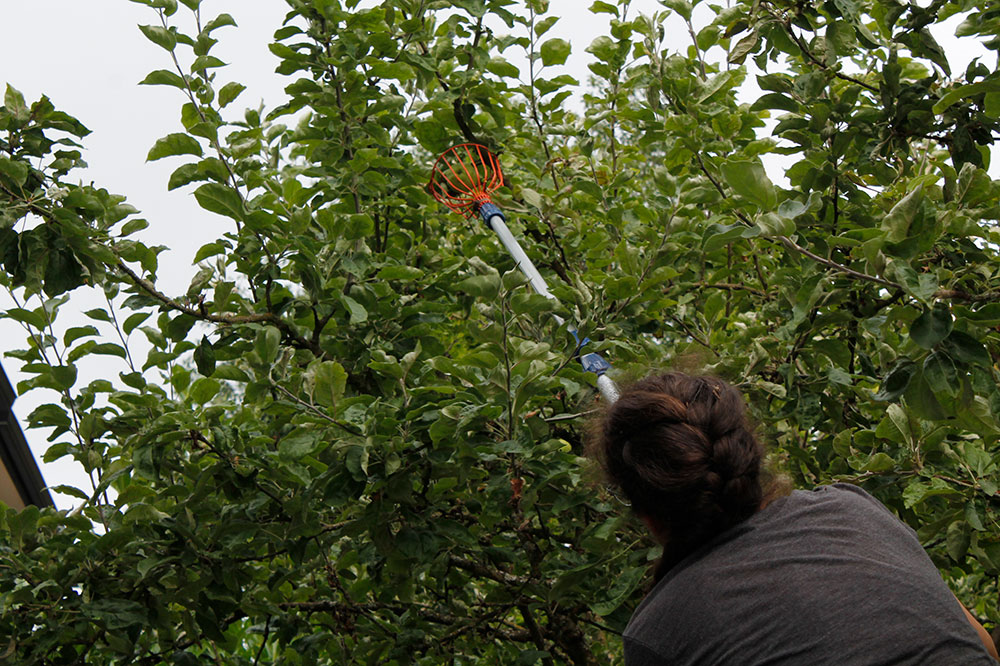
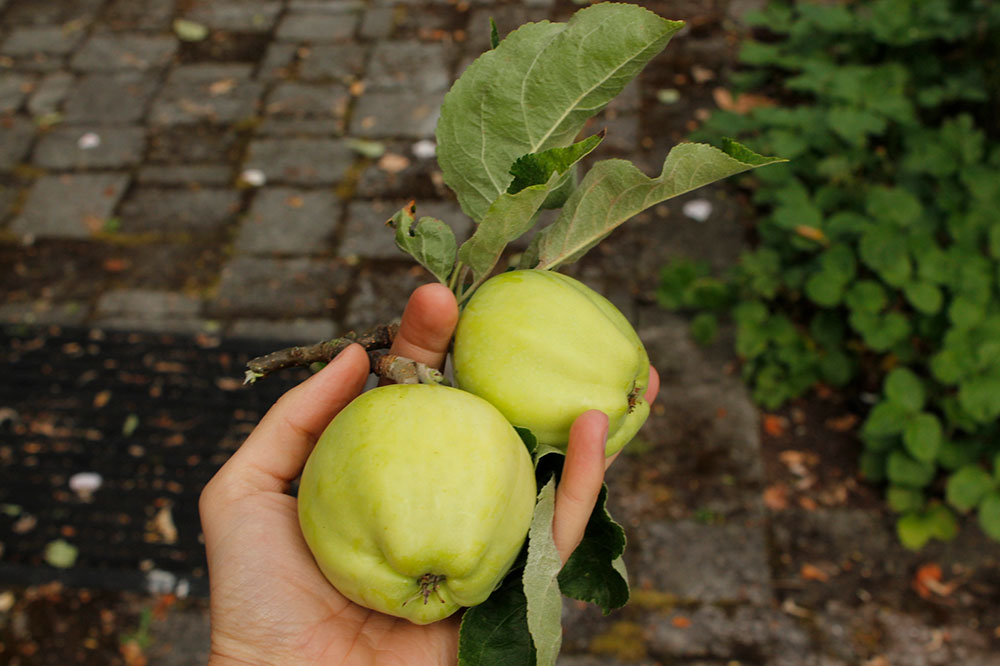
A Vancouver Fruit Tree Project volunteer uses a fruit picker to harvest translucent apples from the upper branches. When harvested right these apples are rated ‘A Grade’ and are put in the donation box. When a fruit picker messes up and the apples land with a plop against the cobble stones below, the fruit is put in the box for volunteers. Photos by Michelle Gamage.
I fill a heaping bag full of castoffs — bruised apples that fell from the canopy or worm-hole knotted specimens — and, after carefully cutting out the bad bits, have enough fruit to make two massive apple crumbles for my family.
An hour of work for each crumble. Not a bad trade — and that’s with 95 per cent of the fruit we harvested being donated.
Why don’t we grow fruit trees like this on every Vancouver corner?
We used to, not so long ago.
Indigenous peoples built forest gardens where plants used for food and medicine were imported, cultivated and carefully tended to.
Colonization disrupted this practice.
It’s important when growing food here to remember that we’re growing on stolen land, says Gillian Der 謝美華, food justice co-ordinator for Renfrew-Collingwood Food Justice at the Collingwood Neighbourhood House.
Colonial land-use systems, like the ones that separate where we can grow food and where we spend leisure time, are tools used to perpetrate cultural genocide because they prohibit Indigenous people from practicing traditional food-growing systems, Der says. This continues today when parks and public spaces prohibit or control what food can be grown there, they add.
Renfrew-Collingwood Food Justice built the Norquay Community Food Forest in the style of a forest garden. The space is open to everyone and grows Labrador tea, camas, elderberries, hazelnuts, Nootka rose, sword ferns and many other native fruit, nut, berry and medicinal plants.
Der says they want to one day have a food-forest corridor that stretches across the city, connecting East Vancouver’s Renfrew-Collingwood neighbourhood to Strathcona downtown.
But why limit yourself to a single corridor when the entire city could be a forest garden, says Jennifer Grenz, assistant professor at the University of British Columbia faculty of forestry and faculty of land and food.
“We forget Indigenous people meaningfully shaped lands and waters since time immemorial to provide medicine, food and technology for people while also caring for our four-legged and winged relations,” says Grenz, who is a Nlaka’pamux woman of mixed ancestry.
Integrating Indigenous food systems like forest gardens into today’s urban setting will take some work. But we can look at models of food sharing and community building in Indigenous societies to help us reimagine what is possible in non-Indigenous urban centres, she says.
To transform urban centres into food forests we need to start feeding our neighbours.
A community used to exist to make sure everyone’s belly was filled, Grenz says. Today communities can help us tap into food networks, or informal trade networks.
Grenz says she’ll trade peas for mushrooms, or exchange canned goods because everyone is always canning something different. When she helps Elders can salmon they’ll often thank her for her time by giving her a couple of cans.
“I do a lot of trading with canned goods,” she says. “My goal is to fill my pantry for a year.”
She’ll also spend a day picking blackberries and canning them with friends.
When you make canned food you keep half, give one-quarter to Elders and one-quarter to someone who needs it, she says.
“Is jam going to feed everyone? No, but these are small meaningful things that we can do to collectively start to have a real impact,” she says.
If you don’t know any seniors in your community who you could gift jam to, this is a great opportunity to head to a community centre and meet some, Grenz adds.
These food networks could extend to farms, too. If a farmer has a labour shortage or food surplus they could invite people to come to the farm, help out with the harvest and take a lot of what they pick home with them, she says. That food could then be further dispersed throughout the community between neighbours. Giving away food for free is always better than letting it rot in the field, she says.
The next step in building a food forest is to meet with our neighbours to talk about what kind of food resources we’d like to see in our communities.
City staff could meet with each neighbourhood to ask what kind of fruit trees, nut trees or berry bushes they’d like to grow and co-ordinate with people interested in taking the lead when it comes to caring for those trees and bushes, Grenz says.
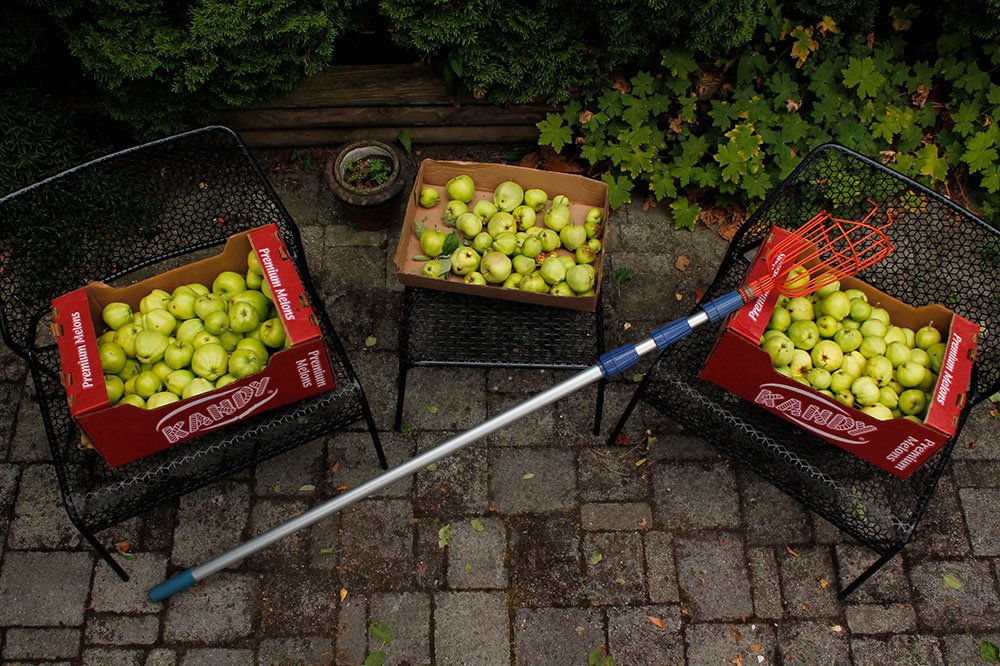
A single two-storey-tall apple tree produces heaps of fresh fruit. After the tree’s owners picked their fill they called in Vancouver Fruit Tree Project, which harvested 40 pounds of tart, fresh apples in two hours using three volunteers. A mature apple tree could produce hundreds of pounds of fruit in a year, says Don Morrison, urban forestry supervisor for the Vancouver Board of Parks and Recreation. Photo by Michelle Gamage.
When I asked Don Morrison, urban forestry supervisor for the Vancouver Board of Parks and Recreation, why the parks board doesn’t plant fruit trees on public boulevards, he cited safety concerns.
The parks board maintains over 150,000 trees in Vancouver and fruit trees require “continuous, ongoing intensive management,” he says.
A mature apple tree, for example, could drop hundreds of pounds of apples in a single year, which risk falling on people, blocking sidewalks or tripping people, he says. If fruit is left on the ground it brings in rats, he adds.
Fruit trees are also vulnerable to infections that make their branches weak and increase the risk of a branch breaking off during a storm, Morrison says.
“We really focus on hazard mitigation,” he says, adding that with the resources the parks board currently has, planting fruit trees everywhere is “not feasible.”
People management will be a major piece of transforming cities and parks into forest gardens, Grenz says. But with our community networks we can reimagine and transform our colonial view of nature, which separates people and their food sources.
“When I see all the resources we pour into ecological restoration in the city I think, ‘Why are we not applying a food systems lens to that?’” she asks.
We restore habitat for our four legged and winged relations, but not for ourselves.
“Why can’t we add fruit trees or edible plants?”
The City of Vancouver has a map of community orchards. These orchards are harvested by community organizations and non-profits, according to a city spokesperson. This map does not include fruit trees on private land, like the tree I picked the translucent apples from with Vancouver Fruit Tree Project.
The spokesperson added the city is in the process of inventorying food-producing trees in parks over the next several months but is not including nut trees.
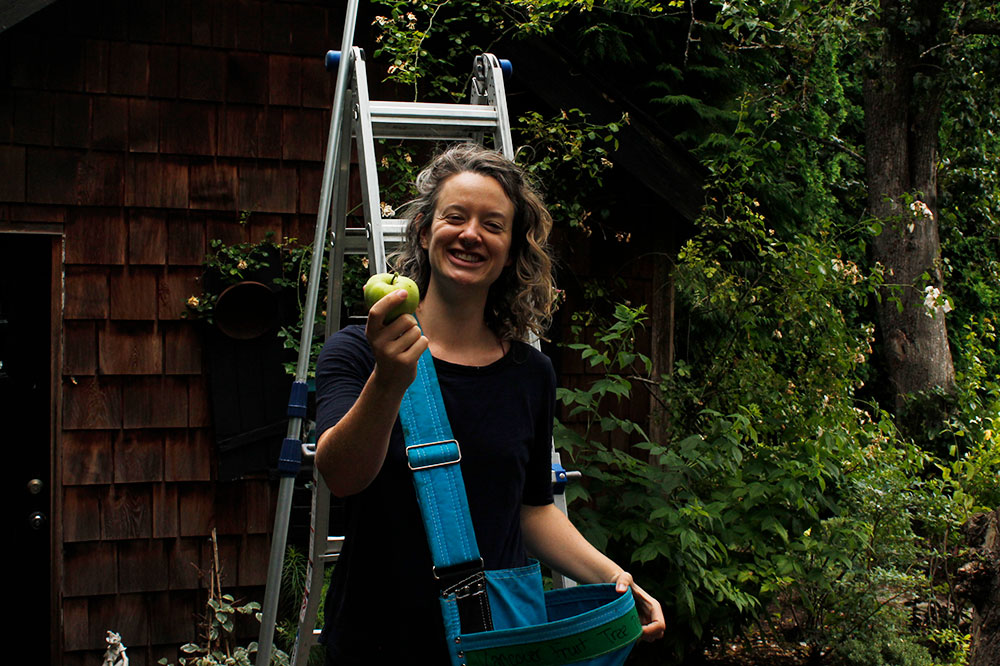
Author Michelle Gamage poses with a translucent apple she picked from the upper branches of a tree in West Point Grey. After two pleasant hours spent harvesting, she took home a bag of bruised, cast-off apples to make apple crumble for her family. New food source unlocked!
Vancouver’s nut trees might not have been mapped out yet but I’m working on building one in my head, noting where hazelnut trees grow on boulevards in the Riley Park-Little Mountain neighbourhood, or where old oak trees drop acorns in Arbutus Ridge. There are plenty of edible nut trees that thrive in Vancouver’s temperate climate, many of which are native to Canada.
Grenz cautions against thinking one plant is better than another just because one is so-called “native” to the area.
Himalayan blackberries, for example, are an extremely invasive species that will aggressively take over a growing space, she says. But they also produce massive amounts of food for birds, humans and the bear that visits Grenz’s property every September to gorge itself on her blackberry patch.
I’ve always devoted weekends in August and September to filling buckets strapped to my bike with blackberries, usually harvested from along the Arbutus bike corridor. This year I’m going to try canning shelf-stable berries instead of cramming them in my freezer, and will try harvesting some nuts from trees I find growing on boulevards and in parks.
I’ll also be working on building out my food network and trading some cans, or more apple crumbles with neighbours.
If you live outside of Vancouver, there may be a fruit picking group in your area. In Powell River, for example, you can connect with Skookum Gleaners and volunteer to pick fruits, nuts, berries or grapes on private property that would otherwise go to waste. If there’s no group in your area, you could consider starting one.
Nuts, fruits and berries are far from the only edible things growing wild around Vancouver.
Next week we’re heading to Vancouver’s beaches to ask what food we can forage without a boat. Along the way we might pick greens and flowers for a salad off a grassy field. Can I safely, responsibly and ethically feed myself while foraging within city limits?





